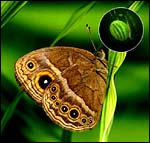|
GM scientists create brand-new butterfly
By Roger Highfield, Science Editor
(Filed: 06/03/2004)
Imagine a world where butterflies are
adorned with advertising slogans, logos and exhortations from the
Government to keep fit and eat less. | |  | | The insect has a jellyfish gene. Inset: its eye |
Although
scientists frown on this application of their work, designer
butterflies are now a possibility after the announcement that one of
their kind has been genetically altered for the first time by
scientists. "RAF circles would be quite cool, as
part of a recruitment campaign," said Brian Millar, creative director
of the creativepartnershipmarketing agency in London. Some
brands might not want to be associated with genetically modifying
nature, he added. And there could be a new form of genetic pollution:
"Brands should consider what would happen if the butterflies breed.
Would this produce unthinkable mutant Coke/Pepsi/McDonald's/Burger King
offspring? These would have to be hunted down and eradicated by a new
breed of brand entomologists." The creation of the
first GM butterfly is part of a programme to understand how patterns
are laid down, rather than a plan to enable companies to write designs
on their wings. Dr Antonia Monteiro and colleagues at the State
University of New York, Buffalo, inserted into an African butterfly a
marker gene from a jellyfish, creating the first GM butterflies that
contain DNA from another species. The research on
the butterfly Bicyclus anynana is published in Proceedings of the Royal
Society: Biology Letters and provides the first demonstration of
"germ-line transformation" in a butterfly, in which novel genes are
injected into embryos and then are passed down to subsequent
generations. The jellyfish gene, a common marker
gene, was chosen for its ability to fluoresce, providing an easy method
of tracking where it was being used in the insect. Under the glow of
blue light, the eyes of the insect fluoresce green. In
all, seven GM butterflies were produced from the experiments. All of
them made use of the jellyfish marker gene - enhanced green fluorescent
protein - in their eyes. The achievement marked a
turning point in the study of these insects, Dr Monteiro said. The team
could now introduce genes of its choice to uncover the secrets of how
they regulated wing colour patterns. This means it would be possible to put markings on butterflies by scanning their wings with a laser.
|




![]()